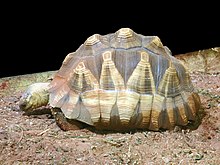Ploughshare tortoise
| Angonoka tortoise | |
|---|---|
 |
|
| Scientific classification | |
| Kingdom: | Animalia |
| Phylum: | Chordata |
| Class: | Reptilia |
| Order: | Testudines |
| Suborder: | Cryptodira |
| Family: | Testudinidae |
| Genus: | Astrochelys |
| Species: | A. yniphora |
| Binomial name | |
|
Astrochelys yniphora Vaillant, 1885 |
|
| Synonyms | |
|
|
The angonoka tortoise (Astrochelys yniphora) is a critically endangered species of tortoise endemic to Madagascar. It is also known as the angonoka, ploughshare tortoise, Madagascar tortoise, or Madagascar angulated tortoise.
This species was originally described in 1885 by French zoologist Léon Vaillant, who proposed it as the species Testudo yniphora based on the distinguished shape of the anterior part of the plastron.
The angonoka tortoise (A. yniphora) and the radiated tortoise (A. radiata) are the only species in the genus Astrochelys. Astrochelys is attributed to John Edward Gray, who used the name in his 1873 book Hand-list of the specimens of shield reptiles in the British Museum. The parent family for Astrochelys is Testudinidae, the tortoise family.
The name angonoka comes from the Malagasy word used as the local name of the species. The alternative common name, ploughshare tortoise, refers to the appearance of the gular scute of the plastron.
The carapace is highly domed and light brown in colour with prominent growth rings on each scute. The outer parts of the vertebral are a darker brown. The gular scute of the plastron projects forward between the front legs and curves upward toward the neck.
Males are larger than females, reaching a carapace length up to 17 in (43 cm). The average length of an adult male angonoka tortoise is 414.8 mm (16.33 in) and the average weight is 10.3 kg (23 lb). Females measure at a 370.1 mm (14.57 in) average and weigh 8.8 kg (19 lb) on average.
In the wild, this species is only found in Madagascar, where it is endemic to the dry forests in the Baly Bay area of northwestern Madagascar, near the town of Soalala (including Baie de Baly National Park). The distribution is 25 to 60 km2 (9.7 to 23.2 sq mi) in range around Baly Bay.
...
Wikipedia

